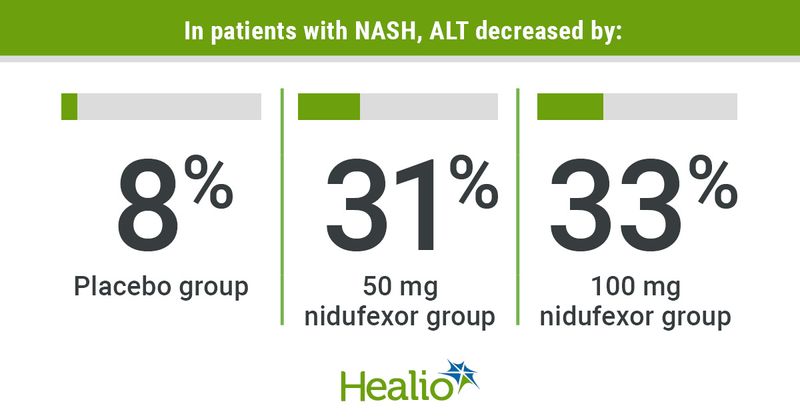Nidufexor significantly reduces ALT levels, hepatic fat in NASH
Click Here to Manage Email Alerts
Two dosages of nidufexor were safe and correlated with significant reductions in alanine aminotransferase levels, hepatic fat fraction and body weight in patients with nonalcoholic steatohepatitis, according to research presented at The Digital International Liver Congress.
“Nidufexor proved safe and generally well tolerated,” Richard Aspinall, BSc, MBChB, PhD, MRCP, from the department of gastroenterology and hepatology at Queen Alexandra Hospital Portsmouth, United Kingdom, said during his presentation. “The most common adverse event was pruritus, particularly in the higher 100 mg dose. The majority of patients reduced hepatic fat by more than 30%.”

Aspinall and colleagues performed a double-blind, placebo-controlled study of 121 patients with NASH randomly assigned to placebo (n = 40) or nidufexor (Novartis; formerly LMB-763) at 50 mg (n= 44) or 100 mg (n = 37) for 12 weeks. Ninety-four patients completed the study. Safety and reduction in ALT served as the primary endpoint. Hepatic fat, pharmaco-kinetics, lipid profiles and anthropometry counted among the other endpoints.
“Following oral administration of nidufexor, the mean T-max was 2 hours; systemic exposure was approximately dose proportional (C-max on day 42, 1.29 M and 2.23 M) with little accumulation (AUC accumulation ratio 1.3 and 0.9) at 50 mg and 100 mg nidufexor respectively,” Aspinall said.
At week 12, investigators noted that in patients who received placebo, ALT decreased by 8%; 31% (14.3 U/L; P = .038) in the 50 mg nidufexor group and 33% (18.8 U/L; P = .0031) in the 100 mg nidufexor group. The placebo adjusted geometric mean hepatic fat decrease was 29% in the 50 mg nidufexor group and 32% in the 100 mg nidufexor group. Body weight decreased in patients who received placebo by 0.31 kg; 1.94 kg (P = .012) in the 50 mg group and 2.1 kg (P = .013) in the 100 mg group. Researchers reported that 86.8% of patients experienced at least one adverse event. The most common adverse event was pruritus, which was observed in 15% of the placebo group, 29.5% in the 50 mg group and 54.1% in the 100 mg group.
According to Aspinall, there was no significant change in total cholesterol, LDL or triglycerides. However, HDL decreased by 12% in the 50 mg group and 16% in the 100 mg group.

